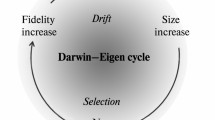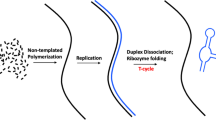Abstract
I present a model for the evolution of the genetic code that seems to predict, in a totally natural way, the origin of the first mRNAs. In particular, the model—bestowing to peptidated-RNAs the major catalytic role in the phase that triggered the genetic code origin—suggests that interactions between peptidated-RNAs led to the synthesis of these ancestral catalysts. Within every group of these interactions, a pre-mRNA molecule evolved that was able to direct all interactions between peptidated-RNAs of that particular group. This represented an improvement in the coding of these interactions compared to the interaction groups that did not evolve these pre-mRNAs. This would represent a natural and intrinsic tendency. Therefore, these molecules of pre-mRNAs were positively selected because they improved the synthesis of the catalysts through this first form of coding of interactions among peptidated-RNAs. Thus, according to the model were the pairings—involving a base number greater than three (ennuplet code)—between peptidated-RNAs and pre-mRNAs that would represent the first form of the genetic code. The evolution of this ennuplet code to the triplet code might have been simply triggered by the natural tendency to make the reading module—that is the interactions between peptidated-RNAs and pre-mRNAs—of the different ennuplets to the triplet uniform, because in this way the heterogeneity existing in interactions between the aminoacylated or peptidated-RNAs and pre-mRNAs was eliminated. That is to say, there might have been the natural tendency toward the triplets because these would have made these interactions more efficient, given that the ennuplets were at least more cumbersome and therefore less economic and with an inferior adaptive value; and also because the triplets would represent the simpler choice among that available given that the doublets would have codified too few meanings and quartets instead too many. Therefore, the genetic code would result from a very long era of interactions among peptidated-RNAs under the continuous and fundamental selective pressure for improving catalysts’ syntheses and thus catalysis. The model is strongly corroborated by the explanation that the tmRNA molecule (transfer-messenger RNA) would seem to be the very molecule of pre-mRNAs that the model predicts. In other words, the tmRNA would be the molecular fossil of the evolutionary stages that led to the appearance of the first mRNAs.

Similar content being viewed by others
References
Barbieri M (2003) The Organic Codes. Cambridge University Press, Cambridge, An introduction to Semantic Biology
Crick FHC (1968) The origin of the genetic code. J Mol Biol 38:367–379
Crick FHC, Brenner S, Klug A, Pieczenik G (1976) A speculation on the origin of protein synthesis. Origins Life 7:389–397
Di Giulio M (1997) On the RNA World: evidence in Favor of an Early Ribonucleopeptide World. J Mol Evol 45:571–578
Di Giulio M (1998) Reflections on the origin of the genetic code: a hypothesis. J Theor Biol 191:191–196
Di Giulio M (2003) The early phases of the genetic code origin: conjecture on the evolution of coded catalysis. Orig Life Evol Biosph 33:479–489
Di Giulio M (2007) Why the genetic code originated. Implications for the origin of protein synthesis. The codes of life: the rules of macroevolution, pp 59–67
Di Giulio M (2008) An extension of the coevolution theory of the origin of the genetic code. Biol Direct 3:37
Di Giulio M, Moracci M, Cobucci-Ponzano B (2014) RNA editing and modifications of RNAs might have favoured the evolution of the triplet genetic code from an ennuplet code J Theor Biol 359:1–5
Eakin RE (1963) An approach to the evolution of metabolism. Proc Natl Acad Sci USA 49:360–366
Eigen M, Winkler-Oswatitsch R (1981) Transfer-RNA, an early gene? Naturwissenschaften 68:217–228
Francis BR (2013) Evolution of the genetic code by incorporation that improved or changed protein function. J Mol Evol 77:134–158
Gillet R, Felden B (2001) Emerging Views on tmRNA-Mediated Protein Tagging and Ribosome Rescue. Mol Microbiol 42:879–885
Higgs PG, Pudritz RE (2009) A thermodynamic basis for prebiotic amino acid synthesis and the nature of the first genetic code. Astrobiology 9:483–490
Hoffmann-Ostenhof O (1959) Der ursprung der enzyme. In: Oparin AI, Pasynskii AG, Braunshtein AE, Pavlovskaya TE (eds) The origin of life on the earth. Pergamon Press, London, pp 197–206
Ikehara K (2002) Origins of gene, genetic code, protein and life: comprehensive view of life systems from a GNC–SNS primitive genetic code hypothesis. J Biosci 27:165–186
Ikehara K, Omori Y, Arai R, Hirose A (2002) A Novel Theory on the Origin of the Genetic Code: a GNC-SNS Hypothesis. J Mol Evol 54:530–538
King GAM (1980) Evolution of the coenzymes. Biosystems 13:23–45
Muto A, Ushida C, Himeno H (1998) A bacterial RNA that functions as both a tRNA and an mRNA. Trends Biochem Sci 23:25–29
Orgel LE (1968) Evolution of the genetic apparatus. J Mol Biol 38:381–393
Popa R (2004) In Between Necessity and Probability: Searching for the Definition and Origin of Life. Adv Astrobiol Biogeophys, Springer, NY, Series, pp 197–205
Rodin AS, Szathmáry E, Rodin SN (2011) On origin of genetic code and tRNA before translation. Biol Direct 6:14
Szathmary E (1993) Coding coenzyme handles: a hypothesis for the origin of the genetic code. Proc Natl Acad Sci USA 90:9916–9920
Wachtershauser G (1988) Before enzymes and templates: theory of surface metabolism. Micro-biol Rev 52:452–484
Wächtershäuser G (1992) Groundwork for an evolutionary biology: the iron sulfur world. Prog Biophys Molec Biol 58:85–201
Wolf YI, Koonin EV (2007) On the origin of the translation system and the genetic code in the RNA world by means of natural selection, exaptation, and subfunctionalization. Biol Direct 2:14
Wong JT (1975) A Co-evolution Theory of the Genetic Code. Proc Natl Acad Sci USA 72:1909–1912
Wong JT (1991) Origin of Genetically Encoded Protein Synthesis: a Model Based On Selection for RNA Peptidation. Orig Life Evol Biosph 21:165–176
Wong JT, Xue H (2002) Self-perfecting evolution of heteropolymer building blocks and sequences as the basis of life In: Fundamentals of Life, Editions Scientifiques et Medicales Elsevier SAS
Author information
Authors and Affiliations
Corresponding author
Rights and permissions
About this article
Cite this article
Di Giulio, M. A Model for the Origin of the First mRNAs. J Mol Evol 81, 10–17 (2015). https://doi.org/10.1007/s00239-015-9691-y
Received:
Accepted:
Published:
Issue Date:
DOI: https://doi.org/10.1007/s00239-015-9691-y




